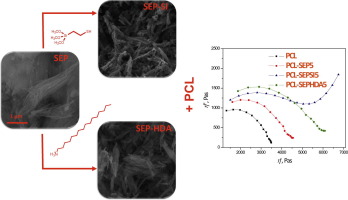当前位置:
X-MOL 学术
›
Eur. Polym. J.
›
论文详情
Our official English website, www.x-mol.net, welcomes your
feedback! (Note: you will need to create a separate account there.)
Effect of sepiolite organomodification on the performance of PCL/sepiolite nanocomposites
European Polymer Journal ( IF 5.8 ) Pub Date : 2017-12-01 , DOI: 10.1016/j.eurpolymj.2017.10.010 Marija S. Nikolic , Rada Petrovic , Djordje Veljovic , Vladan Cosovic , Nadezda Stankovic , Jasna Djonlagic
European Polymer Journal ( IF 5.8 ) Pub Date : 2017-12-01 , DOI: 10.1016/j.eurpolymj.2017.10.010 Marija S. Nikolic , Rada Petrovic , Djordje Veljovic , Vladan Cosovic , Nadezda Stankovic , Jasna Djonlagic

|
Abstract Poly(e-caprolactone) (PCL) based nanocomposites with unmodified and organomodified sepiolites were prepared by solution casting method. The sepiolites were modified with short (3-mercaptopropyl)trimethoxysilane (SEP-SI) by using covalent grafting or with long hexadecylamine (SEP-HDA) by using ionic exchange. In order to reveal the influence of the organomodification on the nanoclay dispersion and the properties of the nanocomposites XRD, DSC, TG, SEM, TEM, optical microscopy, melt rheology and dynamic-mechanical analyses were performed. A better dispersion was achieved when organomodified sepiolites instead of native ones were used as fillers. As deduced from the melt rheology data, by analysis of the Cole-Cole plots, the best dispersion was obtained for SEP-SI nanoclay. The thermal stability was not improved, however in the initial stages of the thermo-oxidative degradation a delay in the weight loss was observed for nanocomposites with organomodified sepiolites. The mechanical properties of the nanocomposites were improved in comparison to PCL, particularly for those with modified sepiolites. In terms of mechanical properties the use of sepiolite modified with HDA gave the best results, as a consequence of better interaction between longer alkyl hydrophobic part of the organic modificator and the hydrophobic PCL matrix.
中文翻译:

海泡石有机改性对PCL/海泡石纳米复合材料性能的影响
摘要 采用溶液浇铸法制备了含有未改性和有机改性海泡石的聚(ε-己内酯)(PCL)基纳米复合材料。海泡石通过使用共价接枝的短(3-巯基丙基)三甲氧基硅烷(SEP-SI)或使用离子交换的长十六胺(SEP-HDA)改性。为了揭示有机改性对纳米粘土分散体和纳米复合材料性能的影响,进行了 XRD、DSC、TG、SEM、TEM、光学显微镜、熔体流变学和动态力学分析。当使用有机改性海泡石代替天然海泡石作为填料时,可以实现更好的分散。根据熔体流变学数据推断,通过对 Cole-Cole 图的分析,获得了 SEP-SI 纳米粘土的最佳分散体。热稳定性没有提高,然而,在热氧化降解的初始阶段,观察到具有有机改性海泡石的纳米复合材料的重量损失延迟。与 PCL 相比,纳米复合材料的机械性能得到了改善,特别是对于那些具有改性海泡石的材料。在机械性能方面,使用 HDA 改性的海泡石得到了最好的结果,这是有机改性剂的较长烷基疏水部分与疏水 PCL 基质之间更好相互作用的结果。
更新日期:2017-12-01
中文翻译:

海泡石有机改性对PCL/海泡石纳米复合材料性能的影响
摘要 采用溶液浇铸法制备了含有未改性和有机改性海泡石的聚(ε-己内酯)(PCL)基纳米复合材料。海泡石通过使用共价接枝的短(3-巯基丙基)三甲氧基硅烷(SEP-SI)或使用离子交换的长十六胺(SEP-HDA)改性。为了揭示有机改性对纳米粘土分散体和纳米复合材料性能的影响,进行了 XRD、DSC、TG、SEM、TEM、光学显微镜、熔体流变学和动态力学分析。当使用有机改性海泡石代替天然海泡石作为填料时,可以实现更好的分散。根据熔体流变学数据推断,通过对 Cole-Cole 图的分析,获得了 SEP-SI 纳米粘土的最佳分散体。热稳定性没有提高,然而,在热氧化降解的初始阶段,观察到具有有机改性海泡石的纳米复合材料的重量损失延迟。与 PCL 相比,纳米复合材料的机械性能得到了改善,特别是对于那些具有改性海泡石的材料。在机械性能方面,使用 HDA 改性的海泡石得到了最好的结果,这是有机改性剂的较长烷基疏水部分与疏水 PCL 基质之间更好相互作用的结果。

















































 京公网安备 11010802027423号
京公网安备 11010802027423号